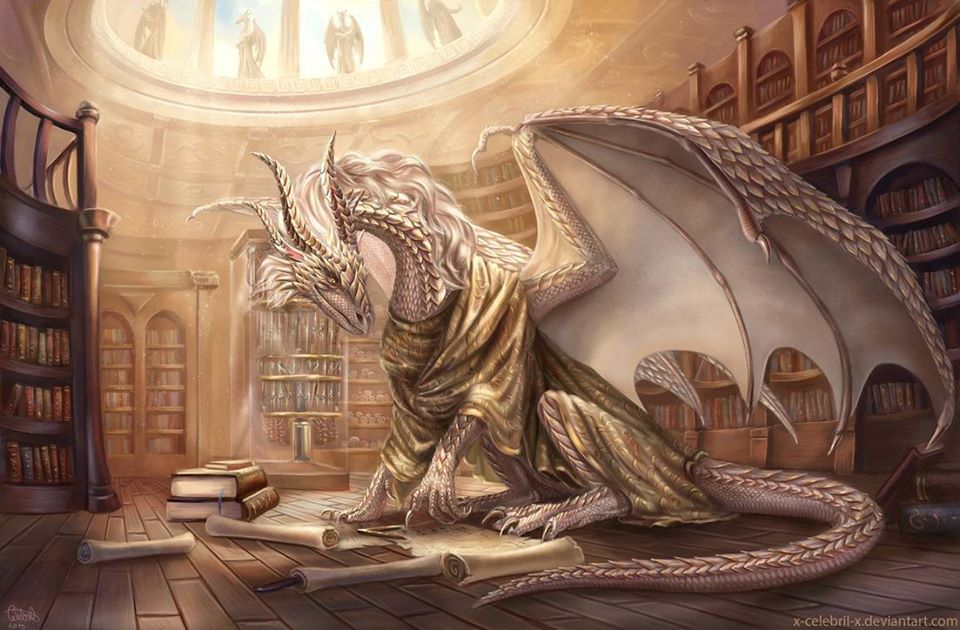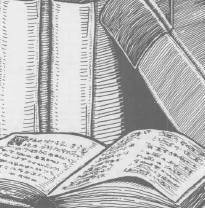

| Shelves | Scrolls | - | Books | Tomes |
| Dragon | Ruins: Libraries | - | Best of Dragon, Vol. V | Dragon 37 |
One of the most trying situations a DM
can face is the overinquisitive party. Its members simply must poke their
noses, swords, etc.
into everything, especially any libraries
that they happen to come
across. And they want to know the contents
of every book. The
popular DM’s excuses of “the paper crumbles
as you touch it”, “it’s
in a language you can’t read”, and “the
ink is too faded to read”
wear thin after a time. I find it more
challenging (and interesting) to
tell the players just what they are finding.
Since bookbinding was a difficult art
(especially without modern
staples) in medieval times, and printing
machines are unknown in
most AD&D
games, the majority of literary works were handwritten on
scrolls. Some few were actually bound
into books, mostly the “important” things (but what a particular castleowner
felt was important
and what your players feel is important
may be two different things).
In any case, I have found the following
system useful in developing libraries:

Shelves: There
are generally 4-8 shelves in any 6-foot wide
section of wall, and a good-sized library
may have 36-90 feet of
shelf-covered walls.
On any particular shelf (I suggest you
number them for easy
reference), you will find:
| Dice | Contents of Shelf |
| 01-95 | Scrolls (10-100 in #) |
| 96-99 | Books (1-10 in #) |
| 00 | Tomes (1-4 in #) |
Scrolls: You
may assume that all scrolls on a single shelf have
to do with one topic, as most librarians
have a fairly efficient cataloguing system. Scroll topics may include (this
is by no means a
complete list):
| Dice | Subject |
| 01-20 | Elvish poetry (01-80, in elvish; 81-95,
in common
tongue; 96-99, another language the party has heard of; 00, in an unknown language) |
| 21-40 | Dwarvish armor making— (extremely technical,
only
truly understandable by armorers who speak dwarvish). |
| 41-46 | Diary page |
| 47-56 | Love letters (may be in common, elvish, orcish, etc.) |
| 57-66 | Accountant records (columns of numbers) |
| 67-94 | Indelible paper (These scrolls were generally
favored
scrolls of the owner, and were magically enchanted so as to never rot or suffer faded ink. They show up under a Detect Magic spell. Reroll for topic of scroll.) |
| 97-00 | Magic scroll
(DM’s choice; reroll for topic of all other
scrolls on a certain shelf, since magic scrolls are supposed to be rare and should never occur more than once per shelf. ) |
Books: Roll
once for each book on a particular shelf. Again, this
is not a complete list.

| Dice | Subject |
| 01-09 | Alchemist's
notebook;
01-83, handwriting too difficult to read; 84-88, incomplete directions for experiments; 89-93, all experiments marked "failure"; 94-99, written almost entirely in chemical symbols; 00, as 94-99, but with a page of translations from chemical symbols to common tongue incl.. Instructions may be usable if the materials are avail; alchemists were notorious for using such things as powdered dragon tooth, sliced gelatinous cube, and the horn of the blue unicorn in their formulas. |
| 10-25 | History of a land |
| 26-42 | History of a castle |
| 43-59 | Religious book (simple prayers) |
| 60-65 | Diary |
| 66-75 | Listing of local plants and their supposed properties |
| 76-85 | Descriptions of local creatures and monsters |
| 86-89 | Collection of elvish poetry |
| 90-97 | A humanitarian's (anthropologist's) report on the inferiority of orcs, kobolds, etc., to the races of man, elf, dwarf, etc. (or vice versa) |
| 98-00 | Magical book; roll on tables in DMG. |
Tomes: Tomes
are generally very large, thick books with tooled
leather covers and locks to keep them
shut. Many are magical, and
all are extremely rare.
| Die roll | Item |
| 01-15 | Magic-User’s tome of spells from first to ninth level (essentially, a very high-level Wizard’s spellbook) |
| 16-30 | Religious tome, including 5 Clerical spells
from each level
1-7. May be of an alignment, but the spells should reflect that alignment. |
| 31-61 | Demonologist’s tome, including all Magic-User
and
Clerical spells for summoning, controlling, dispelling, and turning demons, as well as lore about the demons most likely to be encountered. Should be written in Chaotic Evil or Neutral Evil. |
| 62-76 | Tome of Burning. This includes all spells
(MU, Cleric,
Druid, Illusionist) involving fire, its control, and its creation. |
| 77-00 | Tome of Cold. This includes all spells involving the creation of control of cold |
Most tomes were also guarded, many by locks,
many by spells.
For any particular tome:
| Die roll | Guarded by |
| 01-40 | 1-4 locks only |
| 41-80 | 1-4 spells only |
| 81-00 | 1-4 locks plus 1-4 spells |
| Die roll | Lock type |
| 01-20 | Simple key lock |
| 21-40 | Hidden lock, needs a part of the design pressed to release to catch. |
| 41-55 | Combination (dial) lock |
| 56-75 | Hidden combination lock, requires design
pressed in a
certain combination to release catch. |
| 76-95 | Hidden combination lock, as above, but
only reveals
keyhole (does not release catch). |
| 96-00 | Word lock. To open it, the name of the
tome must be
pronounced. The name is generally inscribed on the cover of the tome in an obscure language. |
If there are two locks or more, at least
one is trapped in some
way, such as with poison.
Tome Guardian Spells are generally
curses, but tend to be 50%
longer lasting, or 50% more effective
and difficult to dispel. These
spells may be deactivated for 15 minutes
by performing a Remove
Curse
spell, a Bless spell, or a complicated passing of the hands over
the tome (DM’s discretion) for each guardian
spell involved.